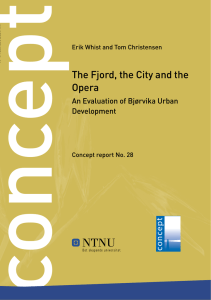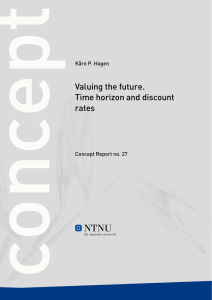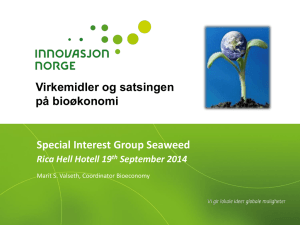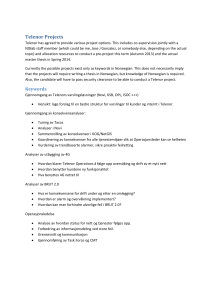Sustainability and Public Investments. Lessons from Major Public
advertisement
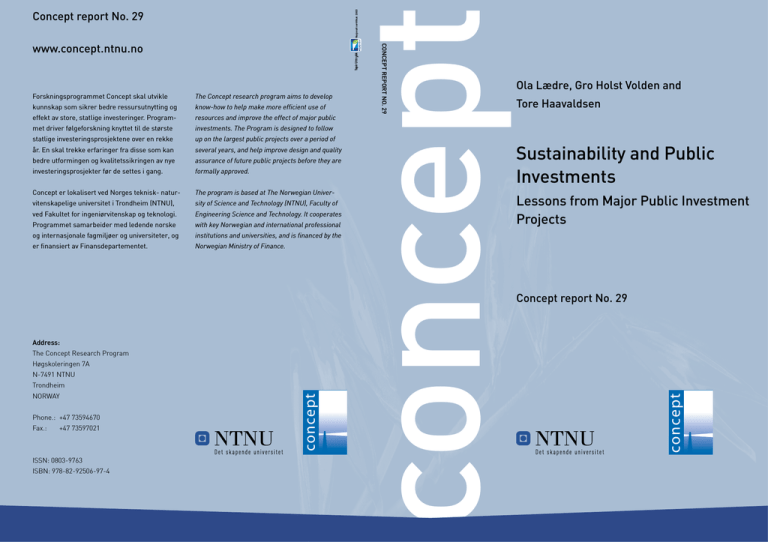
concept Nasjonalt sertifikat: 1660 Concept report No. 29 The Concept research program aims to develop kunnskap som sikrer bedre ressursutnytting og know-how to help make more efficient use of effekt av store, statlige investeringer. Program- resources and improve the effect of major public met driver følgeforskning knyttet til de største investments. The Program is designed to follow statlige investeringsprosjektene over en rekke up on the largest public projects over a period of år. En skal trekke erfaringer fra disse som kan several years, and help improve design and quality bedre utformingen og kvalitetssikringen av nye assurance of future public projects before they are investeringsprosjekter før de settes i gang. formally approved. Concept er lokalisert ved Norges teknisk- natur- The program is based at The Norwegian Univer- vitenskapelige universitet i Trondheim (NTNU), sity of Science and Technology (NTNU), Faculty of ved Fakultet for ingeniørvitenskap og teknologi. Engineering Science and Technology. It cooperates Programmet samarbeider med ledende norske with key Norwegian and international professional og internasjonale fagmiljøer og universiteter, og institutions and universities, and is financed by the er finansiert av Finansdepartementet. Norwegian Ministry of Finance. Address: The Concept Research Program Høgskoleringen 7A N-7491 NTNU NORWAY Phone.: +47 73594670 Fax.: +47 73597021 ISSN: 0803-9763 ISBN: 978-82-92506-97-4 concept Trondheim Ola Lædre, Gro Holst Volden and Tore Haavaldsen Sustainability and Public Investments Lessons from Major Public Investment Projects Concept report No. 29 concept Tapir Uttrykk Forskningsprogrammet Concept skal utvikle Concept report No. 29 www.concept.ntnu.no concept Ola Lædre, Gro Holst Volden and Tore Haavaldsen Sustainability and Public Investments Lessons from Major Public Investment Projects Concept report No. 29 © Concept Research Programme 2012 Concept report no. 29 Sustainability and Public Investments. Lessons from Major Public Investment Projects English summary Ola Lædre, Gro Holst Volden and Tore Haavaldsen ISSN: 0803-9763 (paper version) ISSN: 0804-5585 (web version) ISBN: 978-82-92506-97-4 (paper version) ISBN: 978-82-92506-98-1 (web version) Date: Publisher: 21.03.2012 Concept Reserach Programme Norwegian University of Science and Technology 7491 NTNU – Trondheim Norway www.concept.ntnu.no Responsibility for the information in the reports produced on behalf of the Concept Reserach Programme is on the commissioned party. Views and conclusions is on account of the authors and not necessarily identical to the views of the Concept Research Programme. Concept report no. 29 Summary The main objective of this study has been to contribute to improve the decision-making process of major public investments in order that their sustainability is assured. More precisely, its ambition has been to: 1. Discuss how the concept of sustainability is to be understood when assessing major public investments in early phase. 2. Examine the degree to which the Norwegian quality assurance scheme (KS1) attend to the sustainability of major public investment projects and point to possible reasons that it is not assessed in a proper manner. 3. Examine the need for guidance to the carrying out of concept evaluations concerning sustainability. The term sustainability derives from Latin (sustenare) and is composed of the elements sus (holding up) and tenare (over a long period). In our context the term thus denotes the ability to uphold something over time. More precisely, we understand it as a positive concept, in that it signifies the ability to uphold something that is positive and good for society over time. The point of departure of this study has been the definition of sustainability provided by the Norwegian Ministry of Finance. According to this definition, the sustainability of an investment is: “[t]he degree to which the investment contributes to the realisation of goals [effects] and purposes [wider societal ambitions] after the project is realised and through the expected life cycle. A consideration of net benefit flows over time.” The assessment of sustainability is thus based on an examination of the capability of the project to achieve important goals over time as part of a positive societal process. In addition, it is essential not to limit the assessment only to the intended effects. All impacts that are retraceable to the project needs evaluation – be they positive or negative, direct or indirect, concerning different dimensions (economy, environment, social concerns), and affecting different groups of people in both time and space. In addition, an assessment of flexibility and robustness concerning risk are natural elements of a sustainability assessment ex ante. There does not seem to exist one single analytic tool enabling to grasp all these aspects of the sustainability of an investment. This study refers swiftly the tools available for assessing sustainability that the authors consider the most noteworthy. Their conclusion is that several complementary tools are necessary in order to assess sustainability properly, and that the assessment needs to combine quantitative and qualitative approaches. The way in which the different tools and methodologies are practiced influences largely on whether or not the sustainability of the investment can be assessed. Of special importance in the assessment of sustainability is that the impacts of the project are examined in a time horizon that is sufficiently extensive, that the perspective is sufficiently broad, and that significant risk factors are identified and their influence on the net utility of the investment. Some official demands and guiding principles exist that can be used in the assessment of sustainability. These can mainly be found at two levels. The first level concerns the general political ambition of moving society in the direction of “a sustainable development”. The second level concerns the mandatory demands and guidelines concerning the assessment of public projects. The quality assurance scheme of the Ministry of Finance is an important part of the general political framework, and specifies that an economic assessment (cost/benefit analysis) should be carried out. Concept report no. 29 Economic assessments, such as cost/benefit-analysis alone cannot, however, provide sufficient analysis of sustainability, and needs filling out. No formal guidelines exist that indicate how such supplementary analysis is to be carried out. The study examines further the manner in which sustainability has been taken into concept evaluations through the period 2006-2011 as part of the KS1 scheme. The authors conclude that there exist a potential of improvement concerning the sustainability assessment of the projects examined. The appraisal of what need the project is intended to satisfy comes out as too short sighted and static in several of the analysis. Uncertainties concerning the stability of the societal need is often not identified or discussed. In cases where conflicting interests appear, as for instance in the transport sector (the wish for reduced traffic as opposed to the perceived need for shorter travel time), there exist a significant uncertainty among the analytics of what is to be regarded the purpose of the project (Only one? And if so, which?). It seems that the handling of impacts that are not easily quantifiable needs a more systematic assessment. Both the analysis of non-estimated impacts and especially that of the distributional impacts of the investment tend to be inadequate. Equally, the choice of temporal horizon in the alternative analysis often lacks discussion and justification. Finally, the realism of maintaining sufficient financing during the operational phase and for necessary maintenance is hardly subject to questioning. This impression from the exam of the KS1 reports is to a large degree supported by interviews carried out and by supplementing studies. The study concludes with a list of recommendations on the subject of improving the assessment of sustainability in concept evaluations, with today’s practice as point of departure. The ten recommendations are (in an abbreviated form): 1. Include all relevant risk factors (including stability in overall needs) and assess the need to include more flexibility. 2. Base the assessment on a temporal horizon sufficiently long that also long term and indirect impacts of the project can be included. Use different scenarios is necessary. 3. Make explicit the appraisal of how long term and short term impacts are to be compared. 4. Consider especially the probability for maintaining the financing throughout the entire life span presupposed in the concept. 5. Do not moderate impacts that are difficult to price properly. The temporal horizon of nonmonetary impacts also needs highlighting, and the analysis must describe whether or not they will be strengthened or weakened over time. 6. Indicate which impacts or factors of risk that eventually is not assessed in an explicit manner. 7. Point to possible imbalances in the data material that might lead to misleading model calculations and analysis results. 8. Show how costs and benefits are distributed with regard to different groups that are either directly or indirectly affected (distributional effects). 9. Examine the need for more precise instructions to analysing sustainability, and the need for an accompanying guidance material. 10. Examine the need to formulate common, general goal or a set of criterion for the assessment of sustainability. Concerning the last two of these recommendations, the study concludes that a need exist for clearer guidance to the analytics on how to assess sustainability. These guiding principles need to be formulated at a superior level, i.e. the Ministry of Finance or a sectorial ministry. As the authors observe, there seems to be a widely held view that sustainability cannot be regarded as an “objective” criterion onto which base an evaluation. Since the question of sustainability depends on ponderations of different aspects of both time and space, it will by definition involve morally charged Concept report no. 29 elements. After the examination of the KS1 reports, it seems possible to establish a better and more common practice for the assessment of sustainability. Concept report no. 29 Concept rapportserie Papirtrykk: ISSN 0803-9763 Elektronisk utgave på internett: ISSN 0804-5585 Lastes ned fra: www.concept.ntnu.no/publikasjoner/rapportserie Rapport Tittel Forfatter Nr. 1 Styring av prosjektporteføljer i staten. Usikkerhetsavsetning på porteføljenivå Stein Berntsen og Thorleif Sunde Project Portfolio Management. Estimating Provisions for Uncertainty at Portfolio Level. Nr. 2 Statlig styring av prosjektledelse. Empiri og økonomiske prinsipper. Dag Morten Dalen, Ola Lædre og Christian Riis Economic Incentives in Public Project Management Nr. 3 Beslutningsunderlag og beslutninger i store statlige investeringsprosjekt Stein V. Larsen, Eilif Holte og Sverre Haanæs Decisions and the Basis for Decisions in Major Public Investment Projects Nr. 4 Konseptutvikling og evaluering i store statlige investeringsprosjekt Concept Development and Evaluation in Major Public Investment Projects Nr. 5 Bedre behovsanalyser. Erfaringer og anbefalinger om behovsanalyser i store offentlige investeringsprosjekt Hege Gry Solheim, Erik Dammen, Håvard O. Skaldebø, Eystein Myking, Elisabeth K. Svendsen og Paul Torgersen Petter Næss Needs Analysis in Major Public Investment Projects. Lessons and Recommendations Nr. 6 Målformulering i store statlige investeringsprosjekt Ole Jonny Klakegg Alignment of Objectives in Major Public Investment Projects Nr. 7 Hvordan trur vi at det blir? Effektvurderinger av store offentlige prosjekt Nils Olsson Up-front Conjecture of Anticipated Effects of Major Public Investment Projects Nr. 8 Realopsjoner og fleksibilitet i store offentlige investeringsprosjekt Kjell Arne Brekke Real Options and Flexibility in Major Public Investment Projects Nr. 9 Bedre utforming av store offentlige investeringsprosjekter. Vurdering av behov, mål og effekt i tidligfasen Petter Næss med bidrag fra Kjell Arne Brekke, Nils Olsson og Ole Jonny Klakegg Improved Design of Public Investment Projects. Up-front Appraisal of Needs, Objectives and Effects Nr. 10 Nr. 11 Usikkerhetsanalyse – Kontekst og grunnlag Uncertainty Analysis – Context and Foundations Kjell Austeng, Olav Torp, Jon Terje Midtbø, Ingemund Jordanger, og Ole Morten Magnussen Usikkerhetsanalyse – Modellering, estimering og beregning Frode Drevland, Kjell Austeng og Olav Torp Uncertainty Analysis – Modeling, Estimation and Calculation Nr. 12 Nr. 13 Metoder for usikkerhetsanalyse Uncertainty Analysis – Methodology Kjell Austeng, Jon Terje Midtbø, Vidar Helland, Olav Torp og Ingemund Jordanger Usikkerhetsanalyse – Feilkilder i metode og beregning Kjell Austeng, Vibeke Binz og Frode Drevland Uncertainty Analysis – Methodological Errors in Data and Analysis Nr. 14 Positiv usikkerhet og økt verdiskaping Ingemund Jordanger Positive Uncertainty and Increasing Return on Investments Nr. 15 Kostnadsusikkerhet i store statlige investeringsprosjekter; Empiriske studier basert på KS2 Cost Uncertainty in Large Public Investment Projects. Concept report no. 29 Olav Torp (red.), Ole Morten Magnussen, Nils Olsson og Ole Jonny Klakegg Rapport Tittel Forfatter Empirical Studies Nr. 16 Kontrahering i prosjektets tidligfase. Forsvarets anskaffelser. Erik N. Warberg Procurement in a Project’s Early Phases. Defense Aquisitions Nr. 17 Beslutninger på svakt informasjonsgrunnlag. Tilnærminger og utfordringer i prosjekters tidlige fase Kjell Sunnevåg (red.) Decisions Based on Scant Information. Challenges and Tools During the Front-end Phases of Projects Nr. 18 Flermålsanalyser i store statlige investeringsprosjekt Multi-Criteria Decision Analysis In Major Public Investment Projects Nr. 19 Effektvurdering av store statlige investeringsprosjekter Impact Assessment of Major Public Investment Projects Nr. 20 Investorers vurdering av prosjekters godhet Investors’ Appraisal of Project Feasibility Nr. 21 Logisk minimalisme, rasjonalitet - og de avgjørende valg Major Projects: Logical Minimalism, Rationality and Grand Choices Nr. 22 Miljøøkonomi og samfunnsøkonomisk lønnsomhet Ingemund Jordanger, Stein Malerud, Harald Minken, Arvid Strand Bjørn Andersen, Svein Bråthen, Tom Fagerhaug, Ola Nafstad, Petter Næss og Nils Olsson Nils Olsson, Stein Frydenberg, Erik W. Jakobsen, Svein Arne Jessen, Roger Sørheim og Lillian Waagø Knut Samset, Arvid Strand og Vincent F. Hendricks Kåre P. Hagen Environmental Economics and Economic Viability Nr. 23 The Norwegian Front-End Governance Regime of Major Public Projects – A Theoretically Based Analysis and Evaluation Tom Christensen Nr. 24 Markedsorienterte styringsmetoder i miljøpolitikken Kåre P. Hagen Market oriented approaches to environmental policy Nr. 25 Regime for planlegging og beslutning i sykehusprosjekter Planning and Decision Making in Hospital Projects. Lessons with the Norwegian Governance Scheme. Nr. 26 Politisk styring, lokal rasjonalitet og komplekse koalisjoner. Tidligfaseprosessen i store offentlige investeringsprosjekter Asmund Myrbostad, Tarald Rohde, Pål Martinussen og Marte Lauvsnes Erik Whist, Tom Christensen Political Control, Local Rationality and Complex Coalitions. Focus on the front-end of large public investment projects Nr. 27 Verdsetting av fremtiden. Tidshorisont og diskonteringsrenter Kåre P. Hagen Valuing the future. Time horizon and discount rates Nr. 28 Fjorden, byen og operaen. En evaluering av Bjørvikautbyggingen i et beslutningsteoretisk perspektiv The Fjord, the City and the Opera. An Evaluation of Bjørvika Urban Development Erik Whist, Tom Christensen Nr. 29 Levedyktighet og investeringstiltak. Erfaringer fra kvalitetssikring av statlige investeringsprosjekter Ola Lædre, Gro Holst Volden, Tore Haavaldsen Sustainability and Public Investments. Lessons from Major Public Investment Projects Concept report no. 29 concept Nasjonalt sertifikat: 1660 Concept report No. 29 The Concept research program aims to develop kunnskap som sikrer bedre ressursutnytting og know-how to help make more efficient use of effekt av store, statlige investeringer. Program- resources and improve the effect of major public met driver følgeforskning knyttet til de største investments. The Program is designed to follow statlige investeringsprosjektene over en rekke up on the largest public projects over a period of år. En skal trekke erfaringer fra disse som kan several years, and help improve design and quality bedre utformingen og kvalitetssikringen av nye assurance of future public projects before they are investeringsprosjekter før de settes i gang. formally approved. Concept er lokalisert ved Norges teknisk- natur- The program is based at The Norwegian Univer- vitenskapelige universitet i Trondheim (NTNU), sity of Science and Technology (NTNU), Faculty of ved Fakultet for ingeniørvitenskap og teknologi. Engineering Science and Technology. It cooperates Programmet samarbeider med ledende norske with key Norwegian and international professional og internasjonale fagmiljøer og universiteter, og institutions and universities, and is financed by the er finansiert av Finansdepartementet. Norwegian Ministry of Finance. Address: The Concept Research Program Høgskoleringen 7A N-7491 NTNU NORWAY Phone.: +47 73594670 Fax.: +47 73597021 ISSN: 0803-9763 ISBN: 978-82-92506-97-4 concept Trondheim Ola Lædre, Gro Holst Volden and Tore Haavaldsen Sustainability and Public Investments Lessons from Major Public Investment Projects Concept report No. 29 concept Tapir Uttrykk Forskningsprogrammet Concept skal utvikle Concept report No. 29 www.concept.ntnu.no
